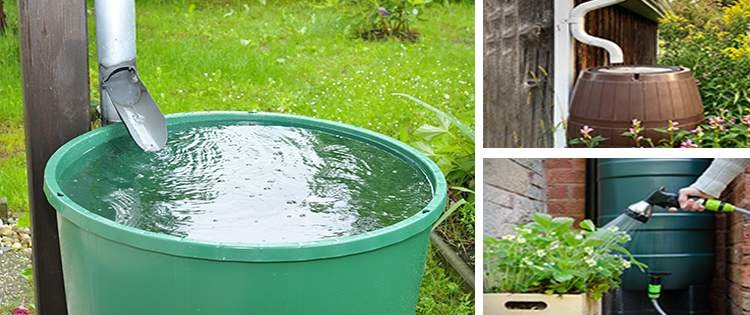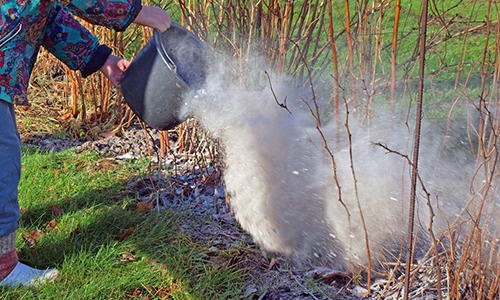Nothing can match the flavor of a ripe, juicy nectarine plucked straight from your own backyard. If you enjoy this delicious stone fruit, you might be interested in growing your own. It’s not only a fun and rewarding activity, but it also allows you to eat the freshest, most delicious fruit.
Growing nectarines at home isn’t as difficult as you would think, and with the proper care and attention, you can yield a plentiful supply of delicious, healthy fruit. In this guide we’ll walk you through the process of growing and harvesting nectarines in your own garden. We’ll cover all you need to know about nectarine trees, from selecting the correct kind to caring for it during the growth season and finally to harvest. Let’s go.
A Brief History
Nectarines are a stone fruit, related to peaches and plums, that have been cultivated since ancient times. In fact, they were mentioned in Chinese writings over 3,000 years ago! They were also grown in Persia and Afghanistan and by the time of the Roman Empire, nectarines had spread throughout Europe.
In the 16th century, nectarines were first brought to North America by Spanish explorers. Since then, many varieties have been developed in the United States and other countries around the world. Nectarines are now grown in warm temperate climates around the world, including parts of North America, Europe, South Africa and Australia.
Nectarines have a unique sweet flavor and delicate texture that make them popular for desserts, preserves and baking. They are also a good source of Vitamin C, potassium and dietary fibre. Nectarines contain antioxidants which can help reduce inflammation and protect against disease.
Nectarines are a versatile fruit that can be enjoyed fresh or cooked. They can be used to make pies, cobblers or jams and jellies, as well as added to salads or smoothies. When ripe, nectarines are juicy and slightly tart with a sweet flavor. They can also be dried or frozen for future use.
Nutritional Benefits
Nectarines are a high source of vitamin C, vitamin A, and fiber, among other nutrients. The vitamins, minerals, and antioxidants in this fruit contribute to their many health benefits.
Nectarines provide twice the vitamin A, slightly more vitamin C, and much more potassium than peaches. They also boast numerous nutrients, including potassium, copper, and vitamins B3. Eating nectarines may help reduce the risk of cancer and heart disease while promoting better eye health.
Nectarines are great sources of beta-carotene, vitamin C, and lutein – nutrients that offer tremendous benefits. They enhance immunity, protect against free radical damage, improve vision health and reduce inflammation. Vitamin C helps keep skin healthy by maintaining collagen production and strengthening the skin’s barrier against environmental pollutants.
Studies have also shown that lutein helps to prevent age-related macular degeneration, which can lead to permanent vision loss if left untreated. All these nutritional benefits make nectarines a great addition to any diet. Feed your plants and they will feed you!
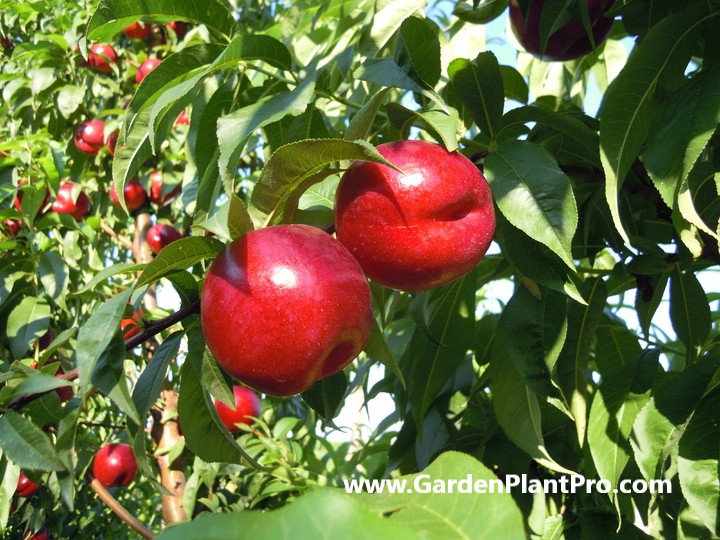
Common Varieties & Their Uses
When it comes to growing nectarines at home, there are a variety of common varieties that can be used. ‘Nectarine Flavourzee’ and ‘Peach Bonanza’ are two popular dwarf varieties that are well suited to pots, while ‘Dorsett Golden’ and ‘Vista Red’ are two standard varieties for those with more space. Each variety of nectarine has its own unique characteristics, but all will produce delicious, juicy fruit when grown correctly.
When choosing a nectarine variety, consider the size of the tree and the flavor of the fruit. ‘Nectarine Flavourzee’ is a smaller tree with a sweet flavor, while ‘Peach Bonanza’ is slightly larger and has a more tart flavor. For larger trees, ‘Dorsett Golden’ produces large fruit with an excellent flavor and is self-fertile, whereas ‘Vista Red’ produces smaller fruit but is also self-fertile.
When planting nectarines, it is important to choose a location that receives plenty of sunlight and has well-drained soil. Nectarines require a lot of water during their growing season but should not be over-watered as this can cause root rot. It is also important to fertilize your nectarine tree regularly to ensure it receives the nutrients it needs to grow and produce healthy fruit.
Once your nectarine tree has been planted and established in its new home, it is important to prune it regularly to maintain its shape and encourage growth. Pruning also helps to increase air circulation around the branches which can help prevent disease. Finally, regular harvesting should begin when the fruit begins to color up; this will ensure you get the sweetest and juiciest fruit possible.
When To Sow
The best time to plant your nectarine tree is in winter, when trees are available as bare-rooted stock in stores. Bare-rooted trees look like sticks with roots, and should be planted as soon as possible. Nectarines should be planted in winter when the trees are fully dormant (when they have dropped all their leaves). If you want to go the longer route, you can also grow from seed.
Choose Location & Prepare The Soil
Choosing the right location and preparing the soil for growing nectarines is an important step in ensuring a successful harvest. Nectarines thrive in sunny spots with well-drained soil and should be planted in late winter. When selecting a planting site, make sure it gets at least 6 hours of direct sunlight daily and has some protection from wind.
In order to create optimal growing conditions, enrich the soil with a good organic compost. If the soil is clay based, add gypsum and fork it in well. Also add plenty of organic matter, such as compost or manure, and work it into the soil before planting.
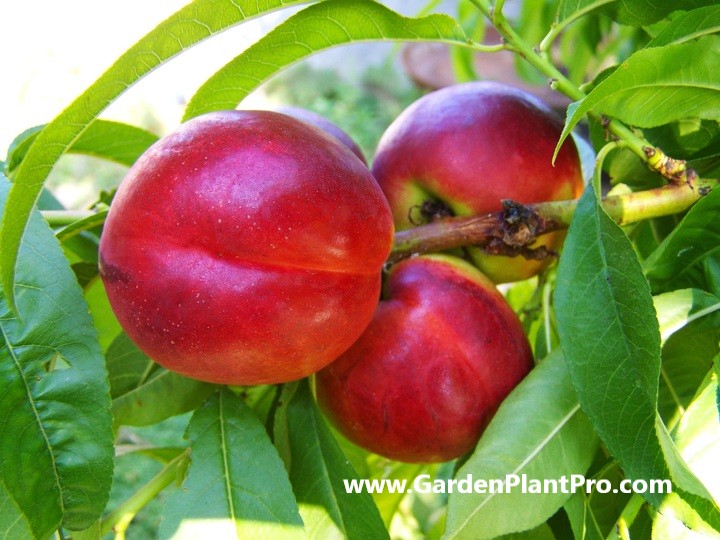
Plant The Seeds, Seedlings Or Cuttings
Planting nectarine seeds is an inexpensive and easy way to start growing your own nectarine trees. Here are the steps to follow:
- Collect seeds: Start by collecting nectarine seeds from ripe fruit. You can either purchase nectarines from the grocery store or farmer’s market, or pick them from a nectarine tree.
- Extract the seeds: To extract the seeds, carefully cut open the nectarine and remove the flesh. Rinse the seeds and let them dry for a day or two.
- Prepare the container: To plant the seeds, you will need a small container, such as a seed tray or a pot. Fill the container with a good quality seed-starting mix or potting soil.
- Plant the seeds: Gently place one seed in each container with a paper towel, making sure to keep the pointed end of the seed facing upwards. Cover the seeds with a thin layer of soil, about 1/4 inch deep.
- Water the soil: Water the soil lightly, making sure it is moist but not waterlogged.
- Provide proper light and temperature: Place the container in a warm and sunny spot, ideally with a temperature between 70-80°F. If you don’t have access to natural sunlight, you can use grow lights to provide adequate light.
- Transplant: Once the seedlings have developed their first true leaves, which usually occurs within a few weeks, they can be transplanted into larger containers or outdoors.
Planting nectarine seeds in late winter or early spring is best as it allows the seeds to germinate in warmer temperatures and ensures that they are ready to be transplanted outdoors in the spring or early summer. Additionally, starting seeds indoors gives them a head start and increases the chances of success for your nectarine tree.
Nectarine seedlings should be planted at the same depth as they were grown in their original container and watered thoroughly after planting. Make sure to leave plenty of space between seedlings so that each tree will have adequate room for growth.
DIY PROJECT: Collect rainwater no matter where you live...
This DIY project is the best way to legally collect rainwater NO MATTER where you live. Get chlorine-free water, cut down on your water bills, and have enough for an emergency situation or to water your garden. Read More Here...
Nectarine cuttings should be taken from semi-hardwood branches at least 8 inches long and will root best when taken in late winter or early spring. Make sure to remove all leaves except the top ones and cut just below a node. Dip the cut end into rooting hormone before planting into damp soil.
If you’re purchased a more established tree from a nursery, it’s time to start digging! Make sure you dig a hole twice as wide and to the same depth as your tree. Plant the tree so that the crown (the spot where all the roots meet) is just slightly below ground level. Backfill with soil around your tree and pat down firmly. Water thoroughly after planting and mulch around the base of your tree.
When planting any variety of nectarine, it is important to keep them free of debris and weeds. They should also not be planted too close to other plants as this may put their survival at risk. Finally, make sure to water thoroughly after planting and mulch around the tree to help retain moisture.
Watering & Fertilizing
Watering and fertilizing are important steps in growing nectarines at home.
Young trees need to be watered regularly and fertilized with a complete fertilizer balanced for fruiting trees in the spring. When watering, it is best to water slowly and form a raised doughnut shaped ring of soil around the outer edge of the plant’s root zone. This helps keep water where it’s needed.
Fertilizing is an excellent way to replenish the nutrients in your soil, especially nitrogen. Nitrogen encourages green vegetative growth, which is exactly what nectarines need. When harvesting, sprinkle a general fertilizer, such as pelleted poultry manure, around the base of the tree.
For container-grown trees, water almost every day during the growing season and give them a high potassium liquid feed every couple of weeks. Repot compact nectarine trees if necessary and use a balanced fertilizer when repotting.
Maintenance
Maintenance is key for keeping your nectarine tree in healthy shape.
Pruning back one-third of the branches during late spring or summer can help improve the overall health and vigour of the tree. Regular maintenance includes cutting out dead, diseased and crossing stems, as well as removing any sucker growth from the base of the tree.
Necessary steps should also be taken to protect your nectarine tree from pests and diseases. This can be done by using natural methods, such as encouraging beneficial insects to your garden, or using chemical products such as insecticides and fungicides.
Regular monitoring of your trees will help you spot potential problems early on, allowing you to take action before an infestation takes hold.
Finally, fertilizing your nectarine tree is an important part of keeping it healthy. During late spring or summer, apply nitrogen fertilizer such as urea, rotted manure, or chemical fertilizer to the base of the tree. This will provide essential nutrients for its growth and development.
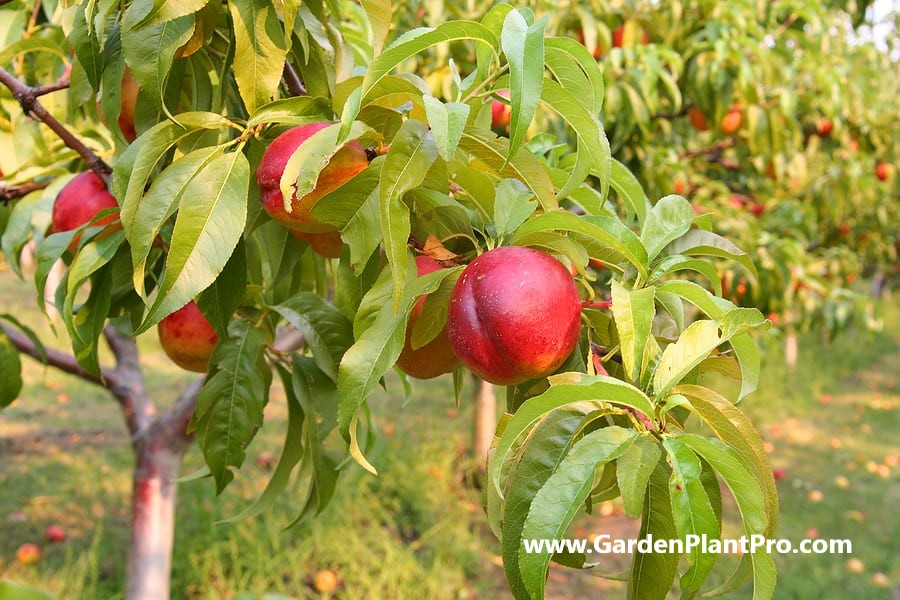
When & How To Harvest
Nectarines are ready for harvesting when they have fully colored and the flesh near the stalk feels soft. To pick, cup it in the palm of the hand and gently lift. Nectarines will be ready to harvest 2 to 4 years after planting.
It is important to keep the area beneath the tree weed free within a 3 foot (1 m.) span during the growing season. Apply organic mulch 3 to 4 inches (8-10 cm.) thick around the tree to help conserve moisture, reduce weed growth and provide nutrients.
When harvesting, it is best to use garden pruners or scissors to cut the fruit off the tree. Avoid using your hands, as this can damage or bruise the fruit. For trees that are too tall for picking from the ground, use a fruit picker or ladder.
Once harvested, store your nectarine fruits in a cool place for up to 10 days. If you plan on storing them for longer, place them in an air-tight container and store in a cool, dark place such as a refrigerator of cellar.
You can use your harvest in a variety of ways. Nectarines can be eaten fresh or cooked for desserts and savory dishes. They can also be frozen for future use or made into jams, jellies and preserves.
Do you have some charcoal in your house right now? We call charcoal a “miracle leftover” for anyone who wants to be a little more self-sufficient and cut costs. That’s because it can help you with so many different things around the house and garden. You can even use it to make an energy-free fridge. Read More Here...
Storing & Preserving
Storing and preserving nectarines is a great way to enjoy the delicious fruit all year round. There are several ways to store and preserve nectarines, including canning, freezing, and drying.
Canning is a great way to store nectarines for up to a year. First, the fruit should be washed and peeled without soaking in water. Next, dip quickly in cold water and slip off skins. Then, take the peeled fruit and place it in sterilized jars. Pour boiling syrup over the fruit and seal the jars tightly. Place in a boiling-water bath for 25 minutes (or according to a recipe). Lastly, remove from the boiling-water bath and cool on wire racks.
Freezing is another way to enjoy nectarines long after the season has ended. To freeze nectarines, rinse off any excess dirt or debris and peel if desired. Cut into slices or chunks of desired size. Blanching is recommended before freezing due to its ability to stop enzyme activity that causes deterioration of flavor and color of frozen food. Place prepared nectarine slices or chunks onto a baking sheet lined with parchment paper in a single layer. Place baking sheet in the freezer until frozen (about 2 hours). Then transfer slices or chunks into freezer-safe containers or bags with an airtight seal for storage up to 8 months.
Drying is another great method of preserving nectarines that can last up to 12 months when stored properly. Choose ripe but firm fruit with few blemishes. Wash with cold water, peel if desired, and slice into 1/4-inch thick rounds or halves. Place slices on drying trays lined with parchment paper or cheesecloth (or use a food dehydrator). Dry at 140°F for about 10 hours until completely dry and leathery but still slightly flexible. Store in an airtight container or jar at room temperature for up to 12 months for maximum shelf life.
Common Diseases & How To Control Them
Nectarines are a popular and delicious fruit, but they can be susceptible to disease. To ensure a successful harvest, it is important to identify any potential diseases and take steps to control them.
Common diseases of nectarines may include bacterial canker, brown rot, peach scab and powdery mildew.
Bacterial canker is caused by a bacterial pathogen that affects the fruit and twigs. It is spread by rain splashes and can cause twig die back, cankers on branches and trunk, and infected fruit.
Brown rot is caused by a fungus that affects both fruits and twigs. It is spread by wind-blown spores which can cause infected fruits to become mummified and twigs to die back.
Peach scab is also caused by a fungus that affects the fruit. It is spread by wind-blown spores which can cause infected fruits to develop scabby spots.
Powdery mildew is caused by a fungus which causes white, powdery patches on the leaves of plants.
To prevent these diseases from attacking your nectarine plants it is important to practice good disease control methods such as: removing and destroying any fallen fruit, infected twigs or mummified fruit; inserting a hardwood stake next to each plant for support; firm the soil down; covering plants with a rain shelter of plastic; providing adequate air circulation around the plants; using fungicides or copper sprays when appropriate; consulting your county extension agent for advice; and monitoring your plants regularly for signs of disease.
It is also important to remember that proper pruning can help control disease by improving air circulation, promoting rapid drying of foliage and soil, and reducing the chance of twig dieback from bacterial canker. Pruning should be done in late summer after fruiting has finished but can be done in early-mid autumn if necessary.
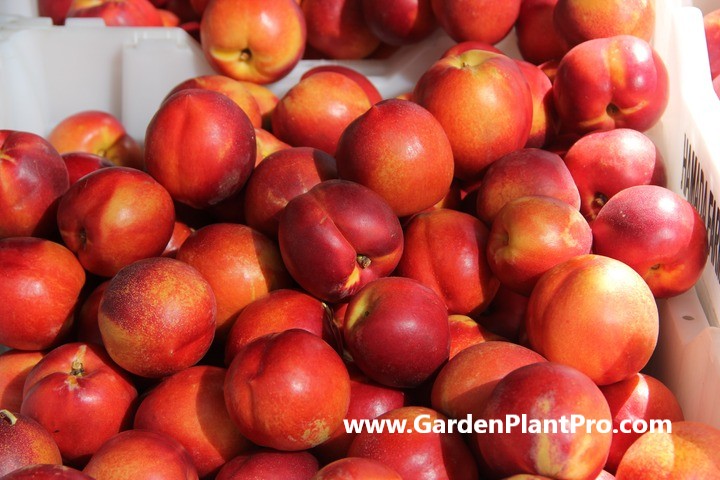
Common Pests & How To Control Them
Nectarines are susceptible to a variety of pests. These include aphids, mites, curculios, and Japanese beetles. To keep these pests at bay and ensure the health of your nectarine tree, it is important to recognize the signs and take preventative steps.
Aphids are small, soft-bodied insects that may be green or brown in color. They feed on the sap from leaves and stems and can cause leaf curling and yellowing. To control aphids, use insecticidal soap or horticultural oil.
Mites are tiny spider-like creatures that feed on the sap of leaves and stems. They are usually red or yellow in color, and can cause stippling on leaves or webs around the fruit. Mites can be managed with horticultural oil sprays or biological control agents such as predatory mites.
Curculios are small beetles that feed on developing fruit and can cause misshapen fruits. To control curculios, spray trees with three layers of Surround before bloom and then renew the spray every seven to ten days (more frequently after it rains).
Japanese beetles may also feed on nectarine leaves and flowers, causing defoliation of plants. Handpicking these insects is effective in small populations but for larger populations, use Japanese beetle traps or apply a pesticide such as permethrin or carbaryl.
CASE STUDY: We've been living off the grid for the last 40 years...
In all that time an electric wire has never been connected to our house. We haven’t gotten or paid an electricity bill in over 40 years, but we have all the electricity we want. We grow everything we need, here, in our small backyard. We also have a small medicinal garden for tough times. Read More Here...
In addition to these common pests, nectarines may also be affected by fungal diseases such as peach scab or bacterial diseases such as bacterial spot. Prune affected branches as soon as possible to reduce spread of disease. Remove fallen leaves and fruits from the ground regularly to help prevent infection from spreading further. Prevent irrigation water from wetting leaves because the water will spread spores. If necessary, apply a fungicide according to label instructions for severe infections.
Other Tips & Tricks
When growing nectarines, there are a few tricks and tips to keep in mind. To ensure that your tree stays healthy, it’s important to monitor for pests and disease and take appropriate action when needed. Removing vertical branching and water shoots from the tree can help promote healthy growth, as well as pruning the tree hard in the late winter or early spring. Mulching with organic matter can help to retain moisture in the soil and prevent weeds from growing around the tree’s base.
Watering is also an important part of growing nectarines. Water regularly to keep the soil moist but reduce watering in autumn and winter. If you live in an area with cooler winters, it is recommended to soak the seeds overnight before planting them, which will give them a better chance of germinating. Copper or oil sprays can help protect against fungal diseases over winter, but should be applied according to label instructions.
Finally, companion planting is a great way to make use of space by planting beneficial plants around nectarine trees. Planting nitrogen-fixing plants such as legumes can help provide extra nutrients for the trees while also providing cover for pests. Other beneficial plants include garlic, chives, mint, oregano and marigolds which are known to repel certain pests from nectarine trees.
Companion Planting
Companion planting is an essential part of growing nectarines at home. It is a practice of planting different plants together in order to benefit each other. This can result in improved growth, better pest control, and increased yields.
The best companion plants for nectarines are comfrey, cover crops, lavender, wildflowers, alliums, and other fruit trees. These plants provide beneficial nutrients to the soil while also helping to keep pests away. Strong-smelling plants such as garlic, onions, coriander, dill, and chives can also be used to repel pests.
When planning a companion planting scheme for nectarines, it is important to consider the climate and location of the trees. Planting in late winter or early spring will allow the trees to become established before the summer heat arrives. Crop rotation is also important in order to ensure that each plant is getting the nutrients it needs.
When planting companion plants around nectarines and other fruit trees, it is a good idea to prepare a large hole by breaking up the soil and adding plenty of well-rotted organic matter. Mulch should also be applied after planting in order to help retain moisture and suppress weeds.
Finally, follow up with regular watering and fertilizing throughout the growing season in order to ensure your nectarine tree receives all of the nutrients it needs for optimal growth and fruit production.
Using Your Harvest
Once your nectarines have been harvested, it’s time to use them!
Nectarines can be enjoyed in a variety of ways. Fresh from the tree, they can be eaten as a snack or added to salads, smoothies and desserts. They can also be cooked in a variety of dishes, from sweet to savory. Nectarines can be used in jams, jellies, pies and tarts. They can also be canned or frozen for later use. For those who enjoy baking, nectarines are great when incorporated into cakes, muffins and breads.
When preparing to eat your freshly picked nectarines, it is important to rinse them under cold water to remove any dirt or debris. Then cut the fruit in half around the stem and twist the halves in opposite directions to separate them. Remove the seed and discard it. The flesh of the fruit can then be eaten as is or used in cooking recipes.
It is important to store nectarines properly if you don’t plan on eating them right away. Unripe nectarines should be stored at room temperature until they are ripe. Once ripe, they should be moved to the refrigerator for up to 5-7 days for optimal freshness and flavor. If you have harvested more nectarines than you need at once, you can freeze them for up to 6 months for later use.
Nectarine trees give gardeners a chance to enjoy delicious fruit that has been grown with their own hands. With proper planting and care from late winter through early spring and regular maintenance throughout the growing season, you will soon be enjoying your own homegrown nectarines!


